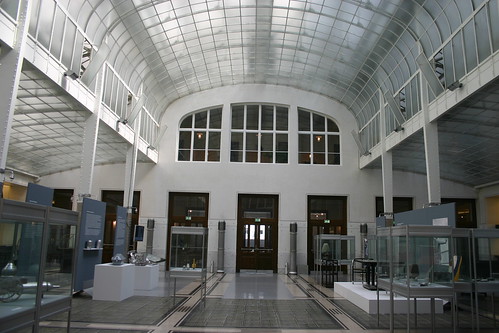The German word of the day is wetter. Das Wesser ist sehr heiss in Los Angeles!
The Postsparkasse (Postal Savings Bank) is a delightful building with pleasing aesthetics designed by Otto Wagner. The building completed in 1912 is still in use today and Wagner’s influence can be seen inside as he designed contemporary teller booths and furniture. Even today, it still feels modern, yet has an old-time historic feeling as they don't use digital electronic clocks for the time and date.
I took a tour of the Vienna Synagogue- the lone temple to survive the war. The synagogue dates back to 1824 and was meticulously planned by Josef Kornhausel in the manner of the residential buildings that stood next to it because only churches were permitted to be self-supporting at the time. This saved the synagogue from destruction by the Nazis as they didn’t want neighboring buildings to catch on fire. The interior of the synagogue is rather small where services take place, but pretty inside with splendid lighting on the bimah.
I finished my day with a visit to the Kunsthistorischen Museum as I wanted to see the other gallery which consists of the old masters from Italy, France, and Spain. While the collection is much smaller than the Flemish/Dutch galleries, it is still a very good collection highlighted by 20 Titian paintings. My favorite Titian painting was "The Girl in the Fur" in which you see a familiar face as the women who modeled often posed for the artist most famously in "Venus of Urbino" which is at the Uffizi in Florence.
Every painting that the mysterious woman surfaced in was done for Franceso Maria della Rovere who was the Duke of Urbino and nephew of Pope Julius II. What stands out about this painting is that an expensive fur cloak has fallen off her shoulder exposing her left breast while she is wearing expensive pearl jewelry, thus the painting exemplifies her beauty.
There were three Caravaggio paintings in the gallery, "David slews Goliath"- a similar painting is at the Farnese in Rome-, "Madonna of the Rosary" and "The Crowning with Thorns." The last mentioned work is the most intriguing as it shows Christ with thorns wrapped around his head while his neck sticks out horizontally showing the agony that he is going through. Caravaggio again displays his trademark tenebrism to illuminate Jesus' upper body and the upper bodies of his two tormenters while the rest of the painting is dark. The usage of illumination reflects the dramatic action that the subjects are enduring. Also, there are only four subjects in the painting as Caravaggio preferred using few people in his paintings. The painting was acquired by the imperial ambassador in Rome in 1810 from the collection of Vincezo Guistiniani who compiled one of the greatest art collections in Europe in the 17th century. The painting was mentioned in the inventory of Guistiniani's collection that it was a supraporte, which is a piece that is to be hung over an entry, which is why the composition has slight foreshortening.
Diego Velazquez was well known for his portraits of the royal aristocrats such as the pope and members of the royal family in Spain. There are about a half-dozen royal portraits compiled by Velazquez at this gallery in Vienna. The crown of the collection is the infant Margarita Teresa modeling in an adorable blue dress. Margarita Teresa was the daughter of King Philip IV of Spain and Maria Anna, the daughter of Emperor Ferdinand III. In this portrait, Margarita is eight years old and her blue eyes stand out especially with the dress that she is adorning. The painting gains sentimental value because it portrays the child in such a delicate manner. Margarita would go on to marry her uncle who became Emperor Leopold I at the age of 15 in 1666. She would tragically die, seven years later at the mere age of 22 while in the process of giving birth to her seventh child.
Monday, September 3, 2007
The grand masters
Subscribe to:
Post Comments (Atom)

No comments:
Post a Comment